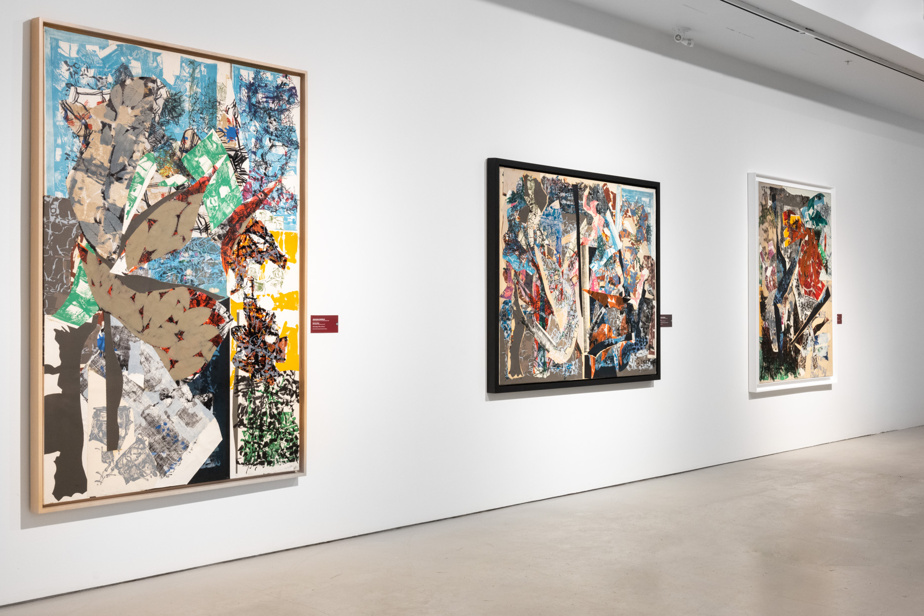The Joliette Art Museum (MAJ) celebrates the centenary of the birth of Jean Paul Riopelle with A place of memory: Contexts of existence, an exhibition of paintings, bronzes and collages by the great Quebec master accompanied by works by five foreign artists. An original and unprecedented deployment that addresses the dimension of uprooting among visual artists.
The Lanaudois museum directed by Jean-François Bélisle had the good idea of starting 2023 with exhibitions on the theme of the context in which artists are created. In parallel with the magnificent exhibition by historian Laurier Lacroix on artists’ studios in Quebec1to the spectacular sculptures by Moe Piuze stemming from an ideation of the workshop, via the sublimation works of Irene F. Whittome, the work on Riopelle by curator Irene Campolmi – established in Copenhagen – offers a strong external perspective. interesting, this researcher of Tuscan origin not being a specialist in Riopelle.

PHOTO PAUL LITHERLAND, SUPPLIED BY MAJ
Two works by Riopelle. On the left, panels for The screen1969, lithograph on silk, 161.3 x 301.5 cm, and, on the right, Indian summer1969, lithograph, 149.2 x 114.7 cm.
The theme of the context of life emphasizes the particular personality of Riopelle. A Quebec artist, but also a man who has imbibed many of the attributes of French culture after having resided for a long time in the mother country. And this, while remaining, from afar, inspired by its roots and Canada’s natural heritage. Drawing on her own experience of migration, Irene Campolmi connects works by Riopelle with those of Jane Jin Kaisen, Linda Lamignan, Dala Nasser, Silvia Rosi and Samara Sallam, five contemporary artists who experience the impacts of mobility.

PHOTO PAUL LITHERLAND, SUPPLIED BY MAJ
Indian summer1969, Jean Paul Riopelle, lithograph, 149.2 x 114.7 cm
Riopelle’s works are notably collages, which… fits well with the idea of multiple identities. Thus, a beautiful dialogue between his lithographs and the work Red in Tooth [Crocs ensanglantés], by the Lebanese Dala Nasser. A textile and videographic installation. The two fabrics placed on the ground have lived. Saturated with ashes, dust and traces of humidity, they were buried for several months by the artist. To bear witness to the environmental, historical and political conditions of a territory in southern Lebanon constantly ravaged by conflicts related to questions of identity and territory. The video follows the path of a river flowing from southern Lebanon to Palestine. A strategic waterway at the heart of tensions between Lebanon and Israel and which bears the traces, in the video, of this almost permanent conflict.

PHOTO PAUL LITHERLAND, SUPPLIED BY MAJ
Red in Tooth, by Dala Nasser
We continue with a creation by Samara Sallam, a Palestinian artist born in Damascus, Syria, and who lives in Copenhagen. His work arrived in Joliette in the luggage of Irene Campolmi. Samara Sallam had told him: “My work can travel, but not me, because I am stateless and cannot leave Denmark. ” This work, Floating Burial [Sépulture flottante], which she carries on her person, expresses the fact that the artist is “landless” and therefore without the right to a funeral “at home”. She therefore plans, “at her last moment”, to immerse herself with her wooden and leather burial. A work on the deprivation of the dignity of the last rest.

PHOTO PROVIDED BY THE MAJ
Floating Burial2019, Samara Sallam, wood and leather, 62 x 170 cm
In the next room, Irene Campolmi presents photographs by Italian artist Silvia Rosi, born to Togolese parents and who lives between London and Modena. His photos evoke the African-inspired fabrics that a Dutch textile company has been creating since 1846. Works in which the artist stages himself. Unfortunately, we cannot reproduce any because of a copyright issue.
Non-binary artist Linda Lamignan was born in Norway to a family from Nigeria and lives in Denmark! From her, the curator retained another story of migration, People who do not travel never arrive at their destination: I did not come alone. An 11-minute video broadcast in a room where she scattered small calabash-shaped lamps, a kind of gourd which also has a history of migration with its seeds which have crossed the seas to change continents.

PHOTO PAUL LITHERLAND, SUPPLIED BY MAJ
Installation by Linda Lamignan
Jane Jin Kaisen, a Korean artist traveling between Denmark and Berlin, represented Korea at the Venice Biennale in 2019, with Community of Sharing [Communauté de la séparation]. This is a 75 min video. A story of shamanism and Korean mythology coupled with the artist’s personal story of his forced migration. Because Korea adopted a one-child-per-family policy, she was adopted by a Danish family when she was 3 months old. The work stems from her first return to Korea when she was 21 and finally discovered her homeland and its traditions.

PHOTO PAUL LITHERLAND, SUPPLIED BY MAJ
Community of Parting video viewby Jane Jin Kaisen
The exhibition thus explores the theme of travel, change of scenery and uprooting with great delicacy. We realize that life experiences transform us, nourish us, build us in a new light. As Riopelle experienced in Europe where he was the first Canadian artist to forge strong ties with the local artistic community. This exhibition by Irene Campolmi will be presented in the summer at the Musée d’art contemporain de Baie-Saint-Paul.
A place of memory: Contexts of existenceat the Musée d’art de Joliette, until May 14.
